October-November 2017
Welcome to Wandering
And to new friends Jimmy, Phil, Josh, Jake, Dene - and the gang at IRS
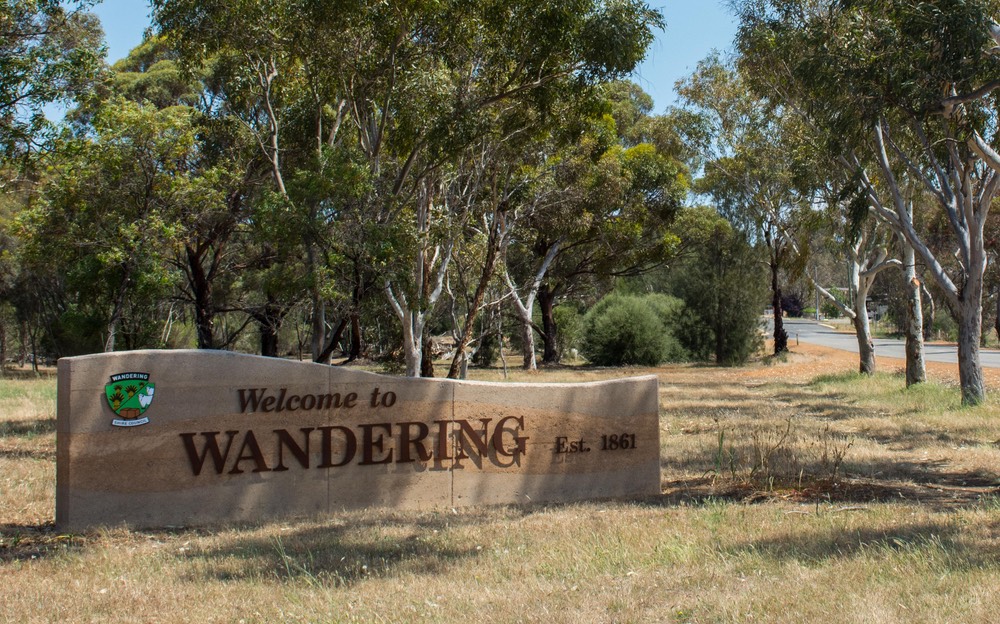
We like to think that our adventures are about the essence of wandering. Not just the physical nature of traveling in the fairly unplanned manner we enjoy, but also the large events that suddenly occur as we travel along — those surprises that lead to abrupt left turns — and where that takes us as travelers. New adventures, new experiences, new friends; they’re all part of the process. The trick seems to be to lean back, take a new and fresh breath, and plunge ahead! Long time readers may remember a story we wrote from Argentina an unbelievable nine years ago that wore as its title, “Well, That Happened”. At least in part this tale can be thought of as the sequel.
But we are putting the cart before the horse. When we officially left the far northwest back a bit, we thought we were well organized: our plan was to move efficiently down the west coast of Australia, stopping to see the sights, maneuver our way through/around/across Perth, and get to know southwestern Australia. Sounds pretty direct and normal; I mean, just how hard could it be?
It even started out that way. Our last message ended with Kathy emerging from the waters of the Ningaloo Marine Park, near Exmouth, grinning from ear to ear after her snorkeling experiences. After drying off and getting the sand out of her hair, we continued moseying down the coast, enjoying the lovely views of the Indian Ocean as we traveled further south. We caught up with our German friends, Diana and Bengt, in the little beach town of Quobba, where they were waiting for us.
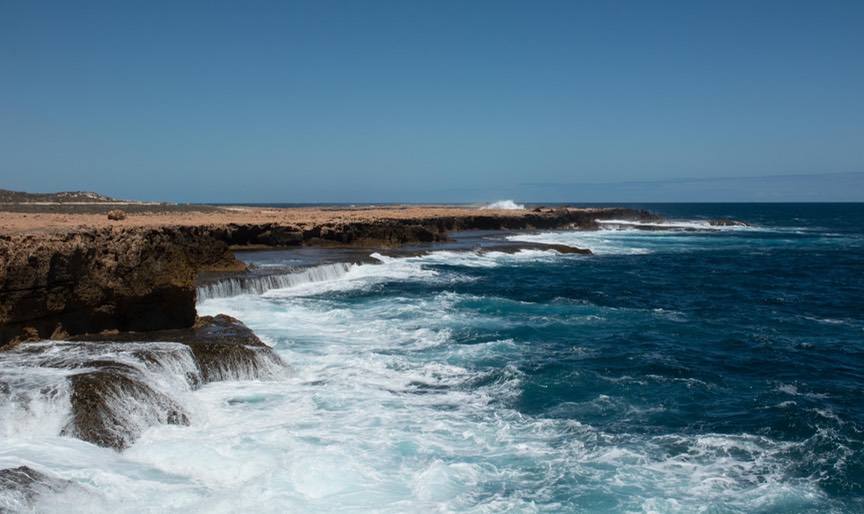
Quobba is a nifty spot, with open camping on the other side of the dunes from the water, a great rocky shoreline, a blowhole of monumental proportions, and nice walks along the beach. It’s a meeting place of the north and south currents, and you could see the confluence off shore. Not long after we arrived, our buddy, Mike, showed up. We knew he was also wandering in Western Australia, and we’d been in touch about getting together, but this was a happy surprise — neither of us knew the other would be at this spot at this time. We didn’t know what he would be driving, but he recognized the Tiger and waved us down. As we were all settling in, he managed to get himself stuck in the sand. Aha! Rick had a chance to “unpack” our new winch and haul him out; it was a great moment, though not so much so for Mike, who was a bit chagrinned but a good sport nonetheless. Rick, at least, was delighted.
We had a great evening, swapping tales and sharing a meal around a fire; the next morning Mike wandered on after we made plans to catch up with him a bit further down the road. We spent the day with the Crazy Germans (self-titled; CGs for short), and then we all parted the following morning. They have less time remaining here in OZ than we do, so we won’t be able to meet again here, but hope to visit them at their home in Germany in a few years.
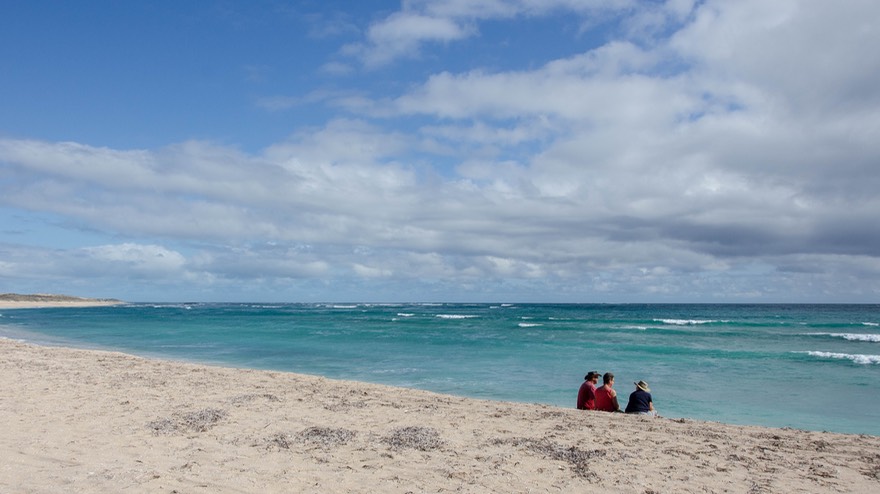
A bit further south, we stopped in Carnarvon, a coastal town in a tropical environment. The mini-climate there makes it perfect for banana growing, among other things; the CGs had brought some of the local delicacy along to share, and they were so good we were determined to buy a whole big bunch (no pun intended) for ourselves. We’d been told that there would be fruit stands along the street in town, but being Sunday there was no one around. So we had to wait until the next day to stock up. (They are really great bananas and we’ve been eating them constantly ever since — Christine, you would be proud!)
Drifting on, we enjoyed stopping for a bit at several places with nice bays and beaches, encountering various beasts, including a goanna (a large lizard-type critter) quietly sauntering by, and feral goats munching away on the nearby scrub. Apparently this is an area where the goats have been dumped over the years, and they are doing just fine, thank you. We saw lots of folks quietly fishing their way through a few weeks of vacation; it’s a nice area.
Coming up to the southern end of huge Shark Bay, a busier, more touristy area, we stopped at Hamelin Pool to look at the stromatolites — ancient life forms that date back over three billion years — rather weird looking but pretty significant, I’d say. They were kind of cool. Most of the attraction in this area is at a place called Monkey Mia, where you can feed dolphins, but we had other spots on our minds. Shell Beach was quite interesting, made entirely out of tiny (i.e., smaller than my little fingernail) pinkish-white lovely cockle shells going for miles and miles along the bay. I walked along, poking around among the shells and being astounded at how very, very small they were. Despite the fact that I was in a protected area, I couldn’t resist gathering up a (very) few and putting them in my pocket.
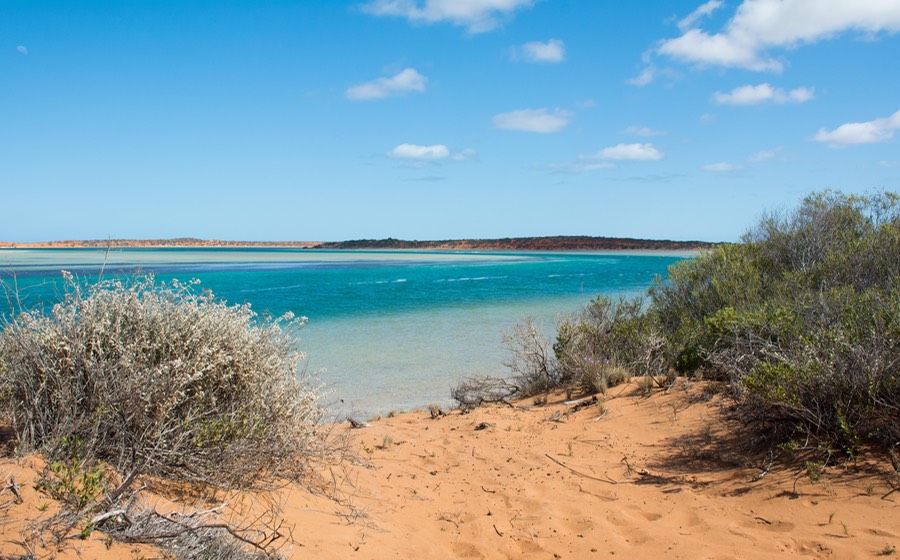
But our big destination in Shark Bay was up into Cape Peron NP, out into the deep, beautiful sands next to the turquoise waters and red dunes. And it was lovely; wow! Such a beautiful place. We waded in the water, took walks, and had a swell time… and wandered into some trouble.
It’s a fair distance to drive up to Cape Peron. Most folks don’t get further up than Monkey Mia, still on bitumen (pavement for you non-Aussies). We had hoped to drive all the way to the top end of the peninsula, but thought we’d start our sand adventure by choosing a campground only part way along. You see, at Cape Peron the roads run in sand, which is not a strong suit for the truck tires La Tortuga wears these days. Hence our choice to go just to the first campground, as we were told the sand got deeper further up. We wanted to see how the first bit went before tackling more. As it turned out, it was still a “bit” too far — for us anyway — but not because of the sand.
Heading towards our campsite we were doing fine, chugging along in lo-range 4wd at no more than 10 mph. Then, coming over a bit of a ridge we suddenly dropped with a wonk down into a hole that we couldn’t see. Didn’t seem that bad at the time, but when we got camped Rick could see that we’d managed to bend Tiger’s rear axle again. Merde!
We enjoyed our lovely camp spot overlooking the pretty waters of the bay and spent a couple of days licking our wounds, then gently made our way back to pavement. The bent axle had joined the loose black tank on the rear of the truck as “issues.” We decided we’d best try to stay on pavement in the near term!
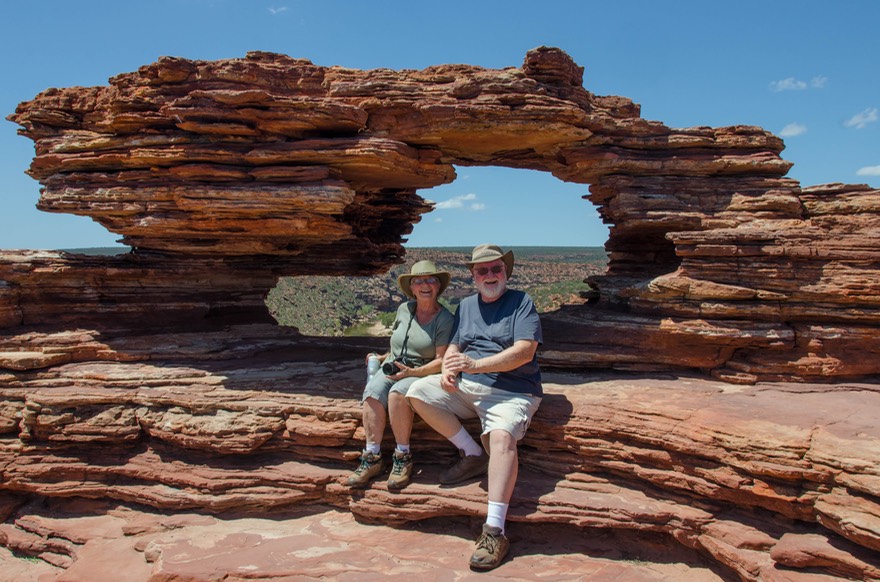
But, but… we didn’t want to skip Kalbarri NP, our next destination down the coast, and there were dirt roads in the park to take us to the places we wanted to see. Didn’t keep us from going, but we did take it pretty easy. Kalbarri is very nice, and a great place to visit. We spent a day among the rugged, eroded rocks with great views over the Murchison River. There’s a very famous spot called Nature’s Window that reminded us of Arches NP in Utah. In fact, the whole park did. Just as lovely.
After Kalbarri, we had a serious discussion. In the end, we decided we needed to get moving and find some help; we needed to locate places to “get things done” for the Tiger. We had now come far enough south that the area was beginning to seem a bit more developed. This was good, in terms of maybe finding a shop that could give us a hand, but also made us a bit sad and regretful to be leaving those remote areas we love so well where we’d been able to drive for hours without seeing another soul.
On a very positive note, we were also far enough south by now that we were seeing striking changes around us — different climate, different landscape, different flora and fauna, the whole package. It was much cooler than further north, and definitely springtime. The wildflowers were in full bloom, and they were bountiful. In our normal semi-clueless manner we had not known it, but apparently this entire part of Western Australia is famous for its wildflowers (particularly after a wet winter, which they’d just had), and we were just entering good areas to see them.
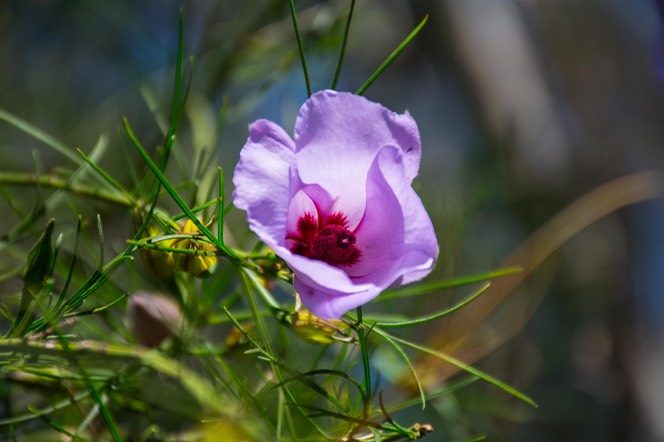
From Kalbarri we drove down to Northampton, where we spent the night in that historic town. The next day we dropped in at a repair shop in Geraldton, self-proclaimed as the biggest (and probably only decent-sized) town between Perth and Darwin — a road distance of just under 4,000kms or about 2,500 miles. The owner, a great guy, poked around some, agreed the axle was indeed bent but that he couldn’t handle it, and gave us some names to check with down in Perth. So off towards Perth we went, but we did decide to pick a route that would please us.
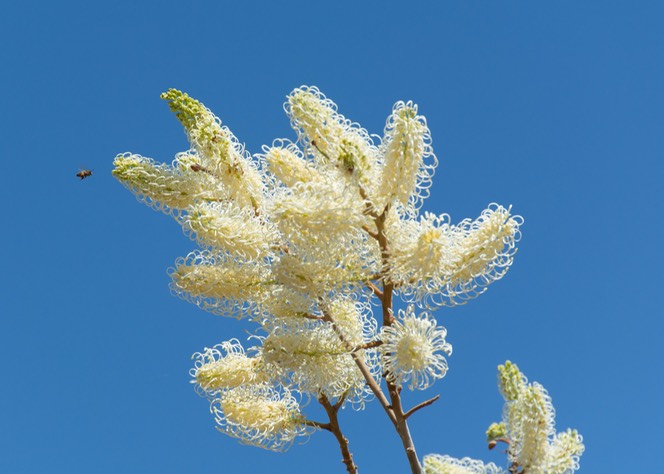
We could have whipped right on down the coast, but we would have had to skip all the things we wanted to see along that road. Also, we wanted to see the wildflowers a little further inland while they were still there. So we found a road we could take where we could drive through major-major wildflower country and have a chance to see some of the beauty of the area. We stopped at a tourist office to get some suggestions and great brochures — Western Australia is doing a marvelous job of enticing you to wander among its attractions. We took their suggestions as to where there would be good viewing, and we had a fine time. We had called and made appointments with a few folks in Perth for early the next week, so we settled in for a pretty drive.
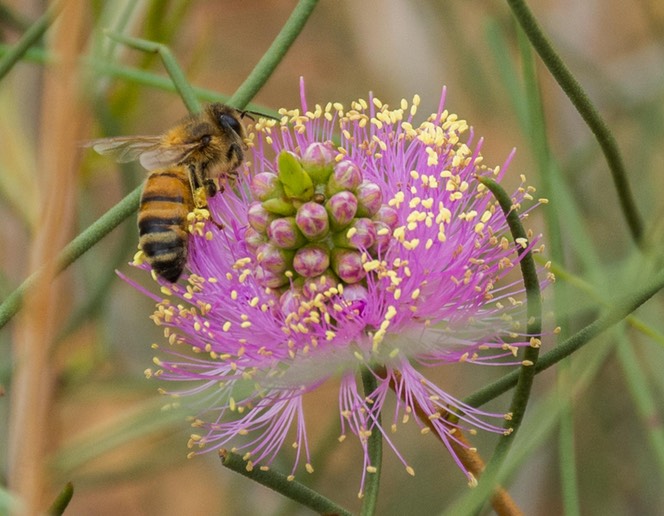
It’s a good time of year to be in western WA — the roadside bushes have new growth, the plants are blooming, all is fresh and pleasant; you’d think it was Spring… oh you’re right, it is Spring. It’s not too hot yet and we even had a few bits of rain here and there. There are plenty of folks out chasing the wildflowers, and we shared overnight spots in nature reserves, or on the edges of towns that welcomed us.
These small nature reserves were a regular sight along the roadsides. They often are merely patches, just big enough to establish a habitat for the birds and small animals that used to “own” the entire countryside before it was turned over to agriculture. Native trees and brush provide shelter and food. They make really nice spots for an overnight. Sometimes there are toilets and trash barrels, sometimes neither, but always a pretty setting and, at least at this time of year, plenty of flowers to be enjoyed by all.
By going a bit inland, we were able to see pretty countryside along with the flowers. We were entering Australia’s great grain belt and found ourselves back among the eucalypts, the grain silos, train tracks, small towns next to fields of wheat, and pipe lines carrying water into the interior.
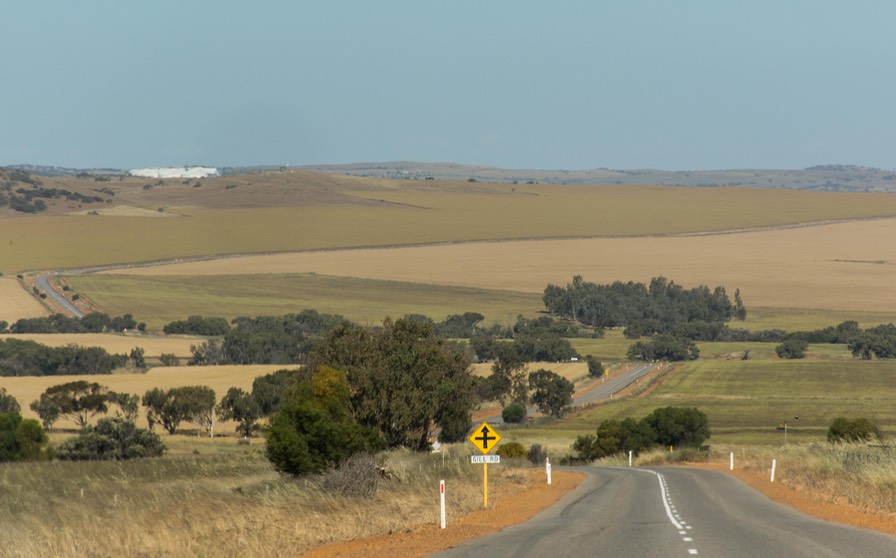
Reaching Perth, we’d come south to what was at that moment a “change of clothes” latitude, shifting from where you automatically put on shorts and sandals, to considering jeans and tennies. It got warmer again pretty quickly, but we enjoyed cooler temps for a few days.
When we say we were “in Perth”, we’re really talking about Greater Perth, often as much as 30-40 kms out from the city center. The area is filled with smaller towns that have grown up over the years, each with its own personality; there used to be some distance between each of them and from Perth; no longer, of course. It’s all a bit of a sprawl of urban growth. The usual. Our searches took us to shops in several of these towns, as we talked to folks about ideas for how to fix what ailed the Tiger. One phone call led to another and pretty soon we had things organized; well, at least planned out on paper.
It was actually pretty cool how the process evolved. We needed to not only straighten the rear axle housing, but also find a way to strengthen it and to tackle the things that Rick, in consultation with various people, felt was causing this now repeated (second time through) difficulty. With help not only from new friends in shops here in Perth, but also our faithful friend and ally Tree at RPM Diesel in Grants Pass, Oregon, we’ve been able to put together and execute a plan of attack that we think will finally put this problem behind us. We’re delighted to tell you that as we prepare to send this message off to you, we are finishing up the repairs and about to head out to new adventures. As to what we’ve done, Rick will handle that in a separate report rather than take the space needed here. Go to The Envelope Pushes Back to read all about it.
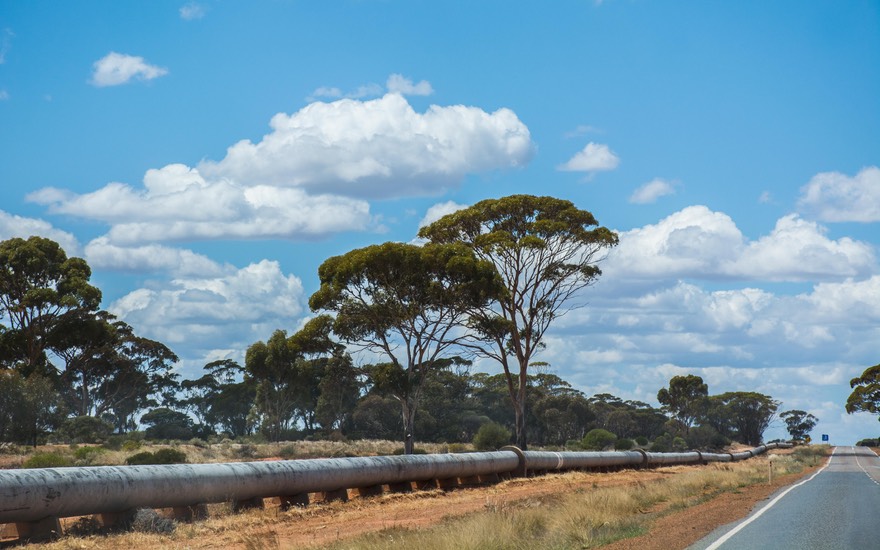
Having made decisions and appointments, and ordered parts from the US, we now had to wait for it all to come together. Not wanting to just sit and stare at ourselves, but also not wanting to go very far from Perth, we decided to do a series of fairly minor loops out into the surrounding area and see some parts of the countryside we might miss otherwise.
Our first decision was to go see some of the goldfields area between Perth and the start of the big central deserts of Australia, about 350 miles to the east. So we took off on the Great Eastern Highway toward Kalgoorlie-Boulder. The Great Eastern is the road from Perth to Alice Springs, if you know your Aussie geography. But it’s only paved until a bit beyond K-B (as we’ve come to call Kalgoorlie-Boulder).
Along the way, we were kept company by a very large water pipe system that starts at a reservoir in the hills above Perth and carries that water all the way to K-B. That pipe, called the Golden Pipeline, completed in 1903, is really a series of 8 pipes, operating in a similar fashion to a series of locks in a river. In that instance, the water is moving a boat either up or down hill; in this case, the water itself is the point of it all.
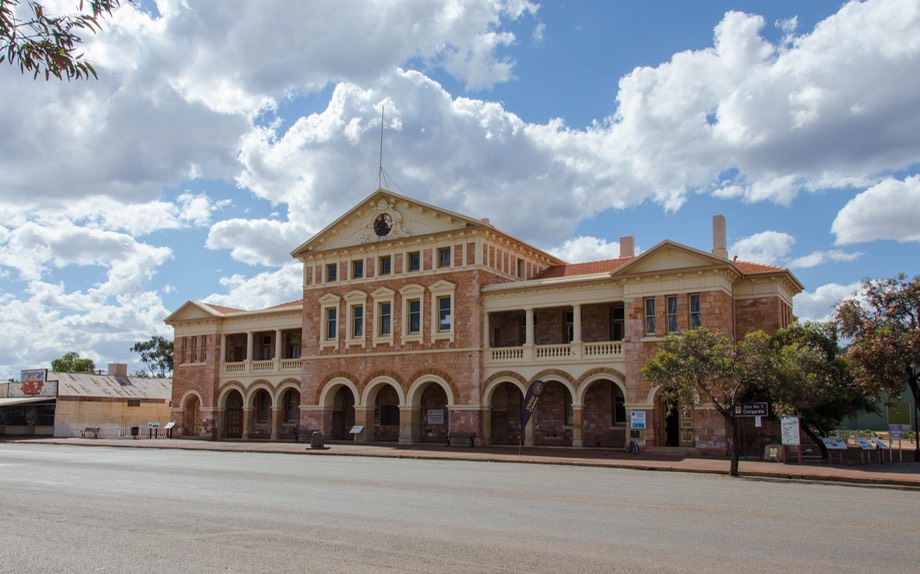
This is nice area, out here in the east, at least at this time of the year; we wandered through a combination of grain fields and mining operations (mostly out of sight), with wildflowers and birds and sunny days to be enjoyed. Along the way we saw a section of Rabbit-Proof Fence. It seems that the fence was constructed way back when with the odd idea that the rabbits that were moving west from eastern Australia (and destroying all in their path) could be stopped by a fence. Now, how silly is that? Anyway, by the time they got the fence finished, the rabbits had long since passed through the area and were further west, so the powers that be constructed a second one, also useless. Anyway. TMI. Parts of it still exist and are pointed out via signage. So there — can rabbits read?
We passed by Bodallin, “home of the largest grain receival station in this region” (small but mighty?), and continued on. We were traveling through beautiful, huge, graceful eucalypts along both sides of the road, and happy to be here. We stopped briefly in Southern Cross, named for the constellation overhead, home to a fine colonial hotel, and spent the night in Coolgardie (pronounced Kool-GA-dee), which has a very nice visitor center and history museum in a charming old town hall that was built in 1898. It is also renowned for having a main street that was designed to be, “wide enough to turn around a camel train”. Nice place; and indeed a nice place for a u-turn if you need one.
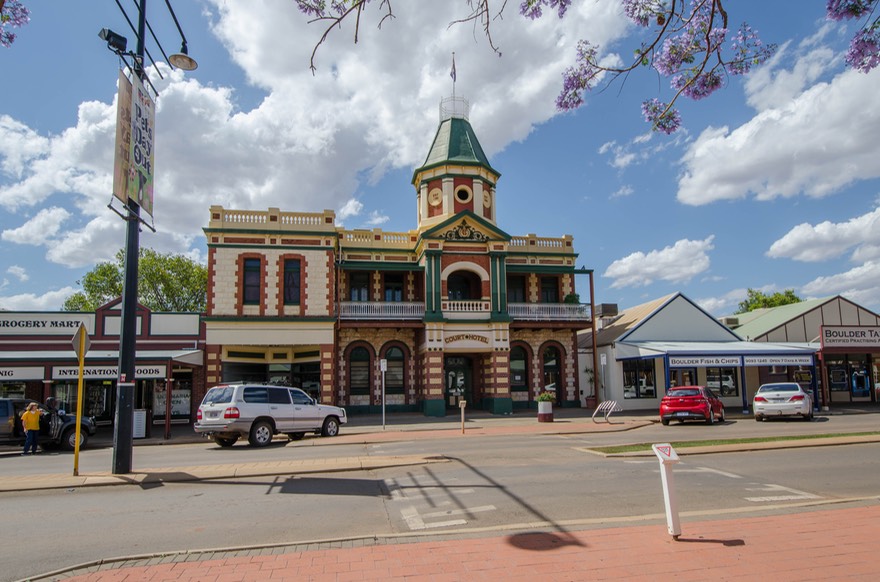
And hence to Kalgoorlie-Boulder (KAL-ga-lee); a bigger town that even had traffic lights, and dominates the countryside. This is the home of the huge Super Pit Mine, quite impressively ugly, and quite enormous; you couldn’t miss it, even when you tried. We visited the town museum and wandered up and checked out the reservoir at Mt Charlotte that holds the water piped in from Perth, and to this day forms a major part of the area’s water supply. There’s good info here about the construction project, and also pretty flowers to be enjoyed. I saw my first Australia jacaranda tree (they are common in California), and there was bottle brush everywhere. We realized that not only did the terrain look like California, we were at a similar latitude, though south rather than north of course. No wonder so many of the plants looked familiar.
K-B is really two towns that got joined together. K is bigger, and has a couple of nice museums, but B is actually a nicer, more charming little town. It has kept its old, quiet atmosphere, whereas K may have more stores but has perhaps lost some of its soul (say we after a one-day visit). In most cases, all any one of these mining towns really has is its history. The big mine is still operating but only for another year or two, so big changes are coming to K-B.
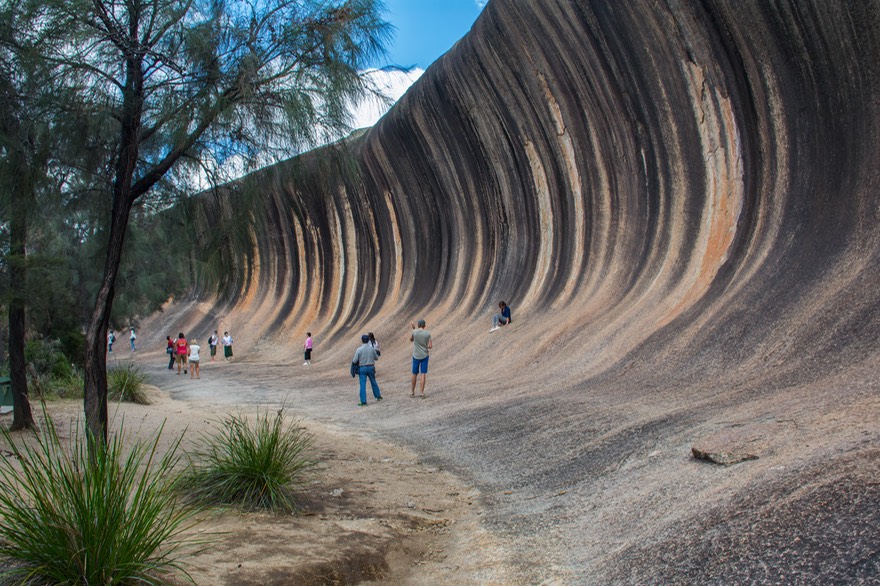
Having gotten our fill of the mining in the area, we started back towards Perth, going back along the Great Eastern Highway through the hamlet of Yellowdine (not pleasantly evocative), and then dropping down on the Emu Fence Road (see above — ditto for emus) to get to Hyden. Our change in direction was a detour to drop down and see Wave Rock, a legitimately interesting formation next to the small town of Hyden. It’s pretty cool, actually, and we enjoyed it once we had survived the Asian invasion that arrived shortly before us. They finally got tired of taking pictures of each other in 17 different slightly different spots with slightly different poses, and got back on the bus. (Sorry.) Once quiet again, Wave Rock (and Hippo’s Yawn) are quite dramatic and worth the trip.
Departing, we started back west, paralleling the Great Eastern but a good 100 miles further south, and soon were back in wheat country. There were lots of tiny towns with cute road signs, e.g., “Karlgarin: Home of the Giggle Races” — with a big crawfish on the sign for good measure (Huh?). The weather turned windy from the west, and then a bit rainy. We went through the Darling Range, with lovely forest and pastures, to Collie, a coal mining town in the hills.
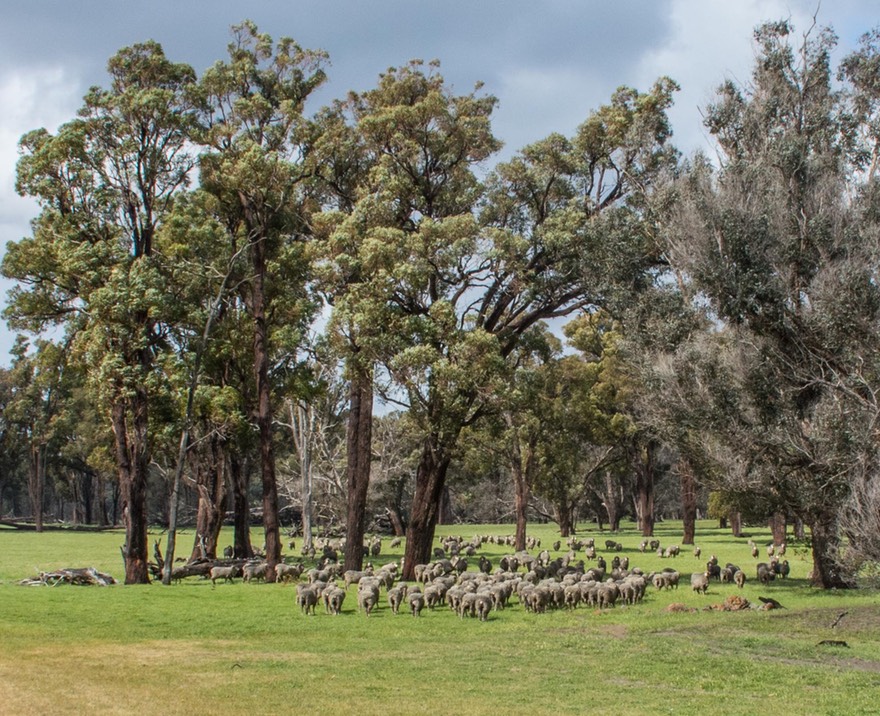
Destination? Stockton Lake, near Collie, where we’d agreed to meet up with our buddy Mike, last seen up at Quobba. We spent a great couple of days with him, chatting about everything under the sun (actually under the rain, as we got a lot of it), including a lot of time talking about Africa. We are hoping to ship there next year, and Mike had overland-traveled there extensively, back a few years. We had a good time, and hope to catch him again in a month or so. Afterwards, we headed back up the hill toward Perth, enjoying the forests, wheat and sheep. Rural Australia; quite nice.
Back in Perth, the stuff we’d ordered hadn’t yet arrived (anyone surprised about that?), so we started a second circle, this time going north through an interior valley on a road that would cut up to the coast at Dongara. Then we would continue our trip south along the Indian Ocean Road to see the remainder of the coastline above Perth. Got that?
It was a really good loop. As we went up the interior, it got quite hot, so we were glad we were heading for ocean breezes. There were butterflies all over, the cattle were clustered under the trees, grasshoppers attacked our front windshield, the seasonal lakes had water in them for just a bit yet, and there were blueberries for sale beside the road. Boy, did I score! I got an entire punnet (535g) for $20. That’s almost 19 ounces for a bit over US $15. Picked that morning and - like - totally fresh. They were incroyable!
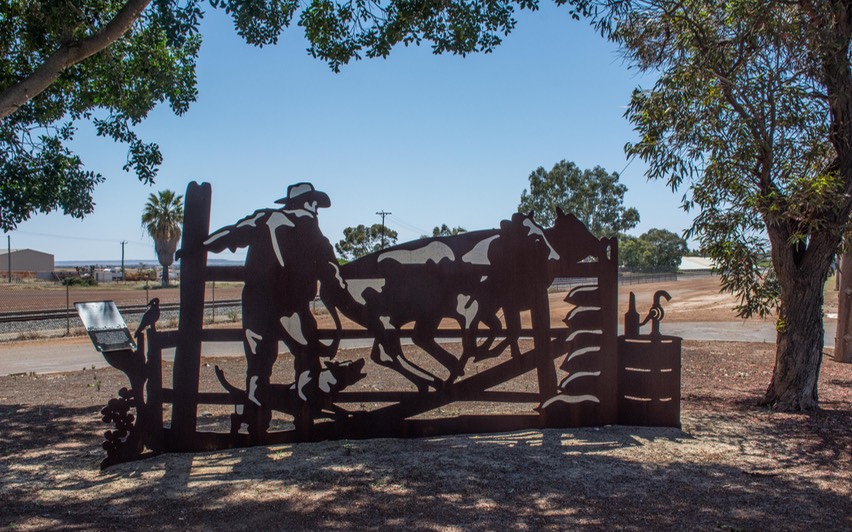
We spent the night in the small town of Three Springs, which had set aside an area for RVs to overnight along the back edge of the village under good tree coverage. It was particularly nice because the temps were in the 90’s when we arrived. Later in the evening the off-shore wind came up and we were much more comfortable. It was Halloween. In case you’re wondering — yes, the Aussies celebrate just like the rest of us. It’s not exactly harvest time, but any excuse for a party! We quietly celebrated the end of our sixteenth year of life on the road, having left home on Halloween 2001.
We were glad to be getting closer to the coast. Fewer trees now, mostly just open fields of grain. We were following the railroad, and every small town had its silo and tiny little depot. These areas do a fine job of encouraging visitors; many of them have spots set aside for overnighting, there are down-home cafes, and every town has its IGA grocery store. May not have everything you’re looking for, but nice to know there will be one in the next town. This is a part of Australia that believes in outdoor metal sculpture, and we passed by lots of places with nice artwork to enjoy. It seems they are being established and maintained by the local shire, and they are very nice. The metalwork reflects the development of that area, with horses & cowboys, things like that.
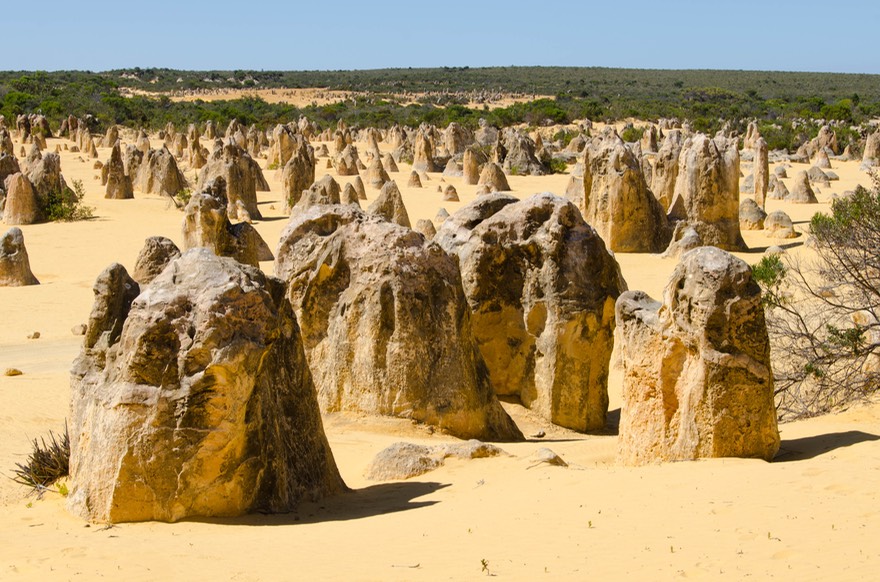
We hit the coast at Dongara, where we stopped for fuel and admired the town’s best feature, huge Moreton Bay fig trees. They are so huge you cannot take pictures of them, so you’ll just have to look them up. Amazingly graceful.
From Dongara we dropped straight down to a place that had been recommended — Cliff Head Beach, about 30 km south. It was right on the water, the sand was firm (Yes! No danger of getting stuck!), and it was lovely. A couple of fellows camping nearby had their golf clubs out and were practicing chipping out of sand traps — until they lost their ball, which we don’t think was ever found. Looked like they were having a great time, regardless.
Heading back into Perth we had three national parks to visit. One, Lesueur, was a bit of a disappointment, as the wildflowers it’s best known for had mostly finished up for the year, but it was a pleasant drive nonetheless. But Nambung NP, home of The Pinnacles, came through in fine form. The Pinnacles, which actually look a lot like limestone termite mounds, are what is left after the perennial winds have eroded the landscape. Pretty cool, actually. Rick kept insisting they had to be petrified TMs, and in all honesty it seems no one actually knows how they were formed — so maybe he’s right.
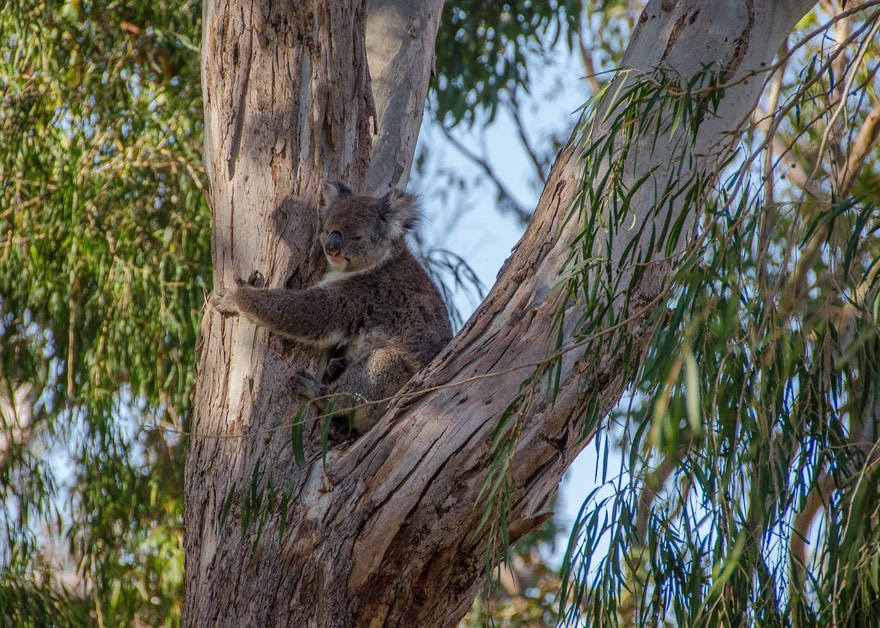
But our big treat was a chance to see the koalas at Yanchep NP. We should have stayed the night, but didn’t know a campground had recently been installed in the park, and had already made other plans. As it was, we were there late enough in the day that the koalas were just awakening for their evening feeding among the eucalypts. They weren’t as active as one might have wished, but they sure were cute, drowsy and slowly moving around. There’s a sanctuary there, and a walkway that wanders among the trees where the animals hang out. We were able to catch a ranger-guided walk and really enjoyed our time; maybe we can come back again.
Back out into the countryside, with the road to Perth now taking us away from the coast, we noticed that the plant life seemed more vivid and healthier, and that the cattle looked in pretty good shape, happily munching away on the plentiful grass. What a difference from when we’d been in drier areas further north.
We came across a sign “Swan Valley — Australia’s first Humane Food region.” I think we must be getting close to Perth! Then we came around a corner and I yelled: “Strawberries!!!!” I paid AU $5 for about 2/3 of a grocery bag of dead-ripe gorgeous strawberries. They were wonderful, and we ate them with absolutely everything — for days. Splendid! And they mixed well with the blueberries, of course. Seventh heaven.
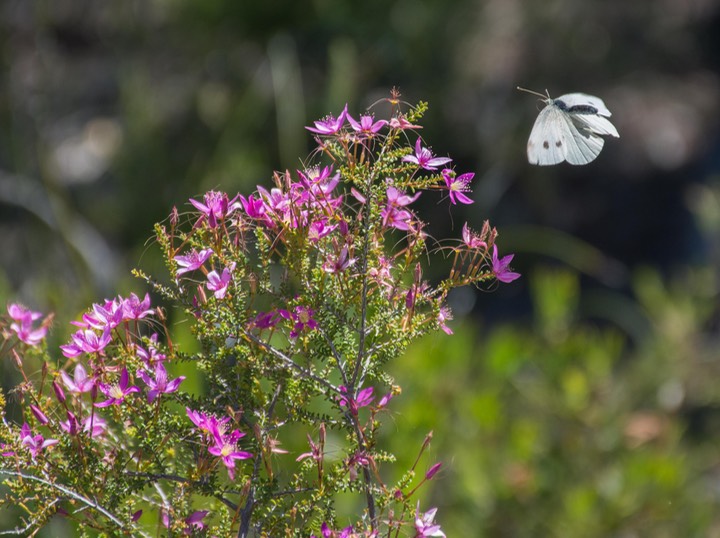
After the weekend, we heard that the truss we’d ordered had shown up at the shop. It turned out it was going to be a bad week to do the work though, so we decided to make yet another loop trip and enjoy more of the area, this time staying closer to home because our new awning had arrived and we wanted to get it installed. Awning you say? Where did that come from? Well, for a long time we’d been thinking about adding a second awning to shade the other side of the Tiger in hot weather and had finally decided to proceed; just before the axle problem developed, of course. Anyway, we needed to get this done as well, so we did. While there at the repair shop, we had a delightful encounter with Mazz and Syd, locals who’ve been on the road for about 12 years now. Proper pros, they were!
So we traveled a bit south of Perth to take a look at the coastline in the Lake Clifton area, then, after the awning was installed, spent the weekend in the charming town of Boddington. Hadn’t been there long when Mazz and Syd showed up, so we had a good chat before parting, and vowed to stay in touch.
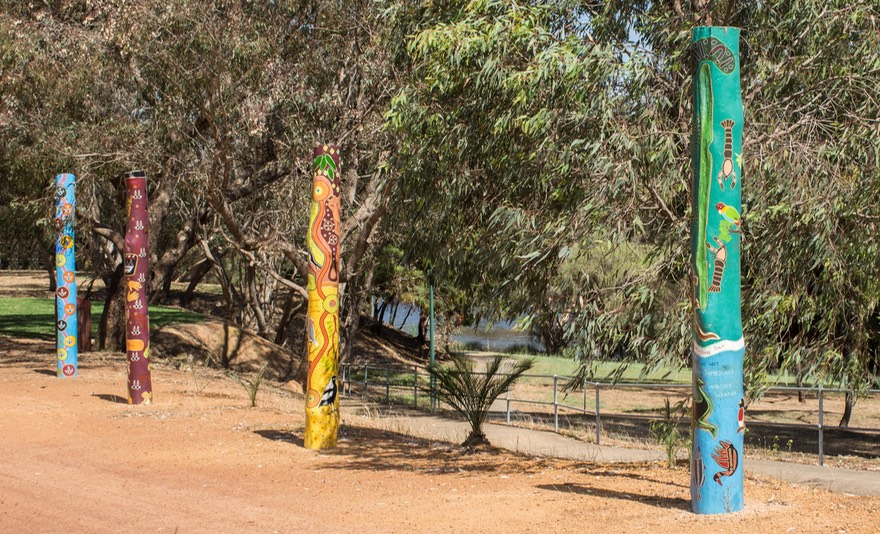
Boddington is great. It’s just a smallish town, with a nice sense of itself, well kept and pretty. They have a lovely community park next to the river, with bandstand, memorials, some very nice Aboriginal poles telling about the different seasons in the area (quite impressive), and a lovely rest area set aside for us traveling folks. Saturday, November 11, was Armistice Day. In the morning a piper played, and then, at the end of the day a small ceremony accompanied the lowering of the flags and the local retired military organization put on a get-together for everyone in the area. Rick got a chance to chat with a retired Australian Army woman who’d spent fifteen years playing the piccolo in their Army band. Rick of course, played the tuba in the US Army in Vietnam, so they traded band stories; you should have been there; these band people are just a laugh a minute. Rick says folks were lucky they didn’t try to oom pah pah and whistle their way through the “Stars & Stripes Forever” march; he says he can still do the tuba part and bets the lady could still do the piccolo. Fortunately the party began breaking up just in the nick of time.
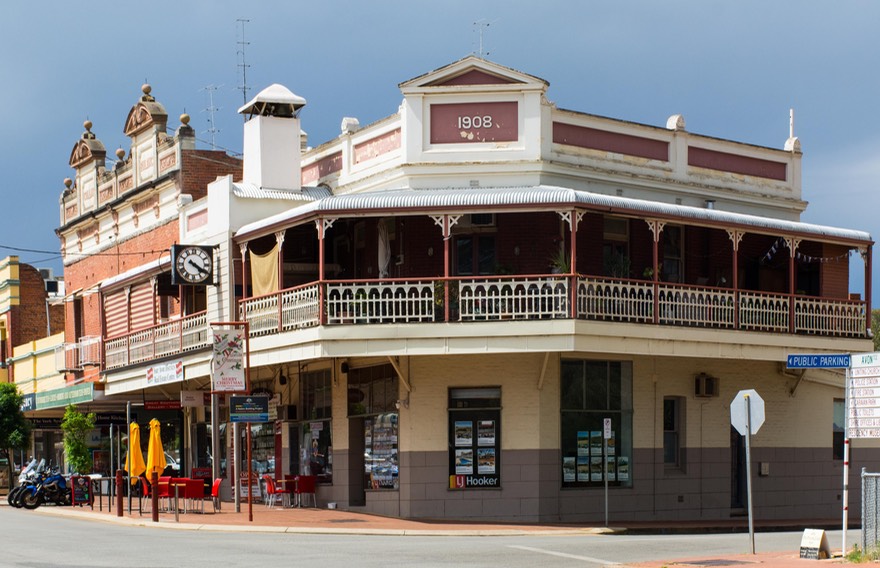
The last leg of this current loop was to swing east far enough to take a new road north. In doing so we passed through the little town of Wandering, population 355, and possessor of the fine sign that provided us with the title for this message. We were also able to stop for a bit in the old town of York, the oldest inland town in Western Australia, founded in 1830, and sited next to the Avon River. It would appear the town was settled by English folks. They have very nice colonial buildings to enjoy and a nice little hardware store where Rick was able to get some screws to fix the refrigerator door hinge; we won’t trouble you with details. York made a nice stop on our way back into the Perth area once again.
Back “home” in Perth, this has been work week, with Jimmy, Josh and Jake handling the removal and replacement chores at Performance West, while Phil and his crew at Final Drive Engineering take care of axle straightening and truss installation. Tiger is on stands with his rear axle out, we are in a motel nearby, Rick is back and forth and doing things on the Tiger that he can handle himself, including finishing up the black tank fix; I am mostly staying cool in the motel and working on projects. With any luck, we anticipate being back on the road by Friday afternoon; though not for the final time of course. As with all such projects there have been delays. Our main one is that as part of the axle fix we ordered new, lighter wheels that have arrived in Perth but are still making their way through Customs. (Rick is being kind here; Kathy would have said “lost in Customs.”) We’ll have to come back for them in yet another week when we’ll hope to also be tying up any other loose ends that arise.
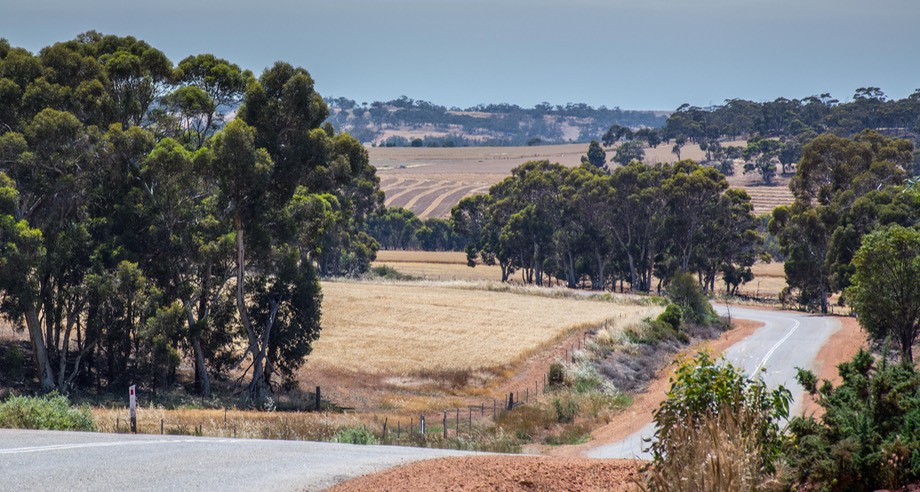
Also during the week we’ve been able to run a few errands and one of them was to visit the IRS. Don’t worry, this is not the Internal Revenue Service (our tax collecting agency in the USA), but instead and more interestingly it is Industrial Rubber Supply.
This visit would not be worthy of mention if the folks at IRS had not been so extraordinarily friendly. One of our small projects was to find a replacement for the handle/lock assembly for the entry door into the Tiger, and our search took us to IRS where we were able to get a good replacement. Anyway, while Rick was taking care of the lock, Kathy took in a bag of travel books we’d decided to ship back to the States to see if she could get them weighed. Well not only did they weigh them, but they also put them in a box and taped it all up for her. They also expressed a lot of interest in who we were and what we were doing and in the end we left them with one of our cards.
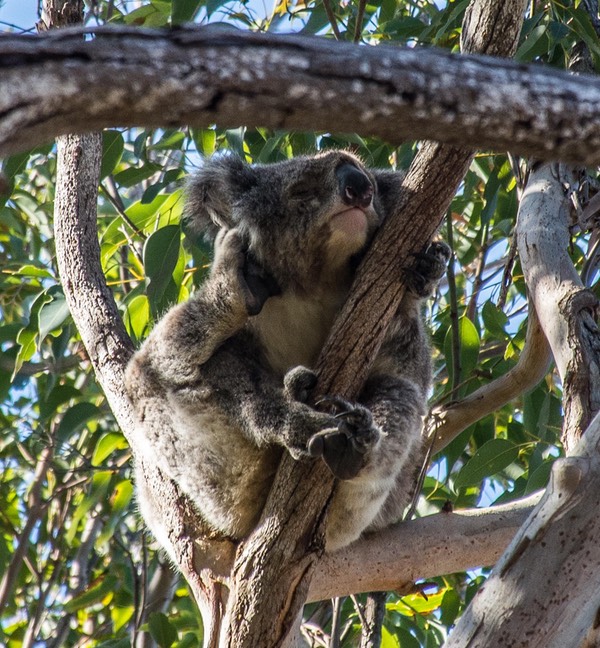
Well, it turned out that when we got to the Post Office, the box we’d been given was bigger than necessary; we found the right size and and sent our bundle off to the States. The next day we were back in the town where IRS is located, following up on something else, so Kathy, being the recycler that she is, wanted to return the unused box they’d given us. So in she goes, only to discover that they’d spent half the morning on our website, were delighted to see her again, and wanted nothing more than to share their excitement with what we were doing. She left with hugs all around, 3 new friends, and a great new warmth toward the IRS.
Once again we are reminded that our travels are made up of encounters, not only with things that can be read about and planned beforehand, but with those serendipitous kinds of things that just happen for no good reason. One thing leads to another, to another, to another, and there is nothing that says the first experience has to have been planned — or even be a positive thing in and of itself. The very wandering nature of our travel leads us to the meetings and encounters and experiences that together form the fabric of our memories.
We hope you are wandering happily as well, wherever you are.
Rick, Kathy and a soon to be whole La Tortuga
"Wandering re-establishes the original harmony which once existed between man and the universe"
~ Anatole France
Needless to say, there are lots more photos for you to enjoy on the photo page for this message